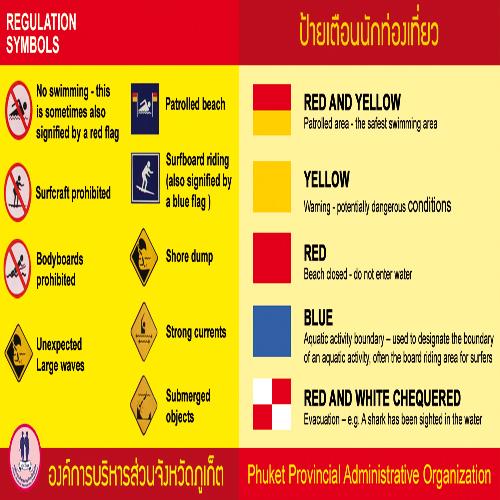In focus: Staying safe at Phuket’s beaches

PHUKET: With the return of the annual southwest monsoon conditions, Phuket’s popular tourist beaches are at their most dangerous. Members of the fledgeling Phuket Livesaving club have once again warned tourists and locals to be vigilant about swimming safety.
Rip currents and powerful waves can easliy catch novice swimmers unaware, and even experienced swimmers must be aware of surf conditions. The Phuket Gazette, with the help of Surf Life Saving Australia (click here for website), who have been instrumental in training and assisting The Phuket Lifesaving Club, has compiled the following tips to increase your and others’ safety when swimming here.
Always swim between the RED and YELLOW flags (click here for flag system)
When you see red and yellow flags on a beach, it indicates that there is currently a lifesaving service operating on that beach. The lifeguards have chosen a section of the beach that is best for swimming and they will closely supervise this area.
Lifeguards pay more attention to the area between the red and yellow flags than any other part of the beach.
Read the safety signs and check for warning flags (click here for safety sign system)
Before you go on to the beach, be sure to read the safety signs. This will ensure you are aware of any warnings or dangers on the beach.
On Phuket’s lifeguard-patrolled beaches, several types of flags are used to indicate surf conditions. You can also find other information to make your day at the beach more enjoyable. You might also find single signs placed on the beach to highlight specific warnings.
Ask a lifeguard for safety advice (click here for resuscitation chart)
Lifeguards are highly trained and very knowledgeable about beach safety and conditions.
When you arrive at the beach look for, and identify, the lifeguards. Feel free to ask them about the day’s conditions, as well any additional beach safety advice they might have for that specific beach – because every beach is different.
Swim with a friend (click here for CPR chart)
Not only is swimming with a friend (or family member) a fun way to enjoy the beach, it is also very sensible. While you are swimming together you can keep an eye out for each other, and if further assistance is required, one person can call or go for help.
If everyone swimming together knows their own limits it is a good idea to share this with those around you so you can all stay within everyone’s comfort zone.
If you need help, stay calm and attract attention
Even the most careful people can find themselves out of their limits in the water.
If you are not feeling comfortable in the water and you require a lifeguard’s assistance to get back to shore, stay calm, raise your arm in the air and wave it from side to side.
This will attract the attention of a lifeguard who will be able to come to your assistance.
You should conserve your energy by floating on your back and staying calm. This will ensure you have the energy to remain afloat until further aid arrives.
HOW TO ESCAPE A RIP CURRENT
A rip current is a strong channel of water flowing seaward from near the shore
How to spot a rip current
• Look for the ‘seam’ where waves are drawn together
• Look for a channel of churning, choppy water
• Look for a steady line of sea foam or debris
• Look for different colored water beyond the surf zone
• Look for a break in the incoming wave pattern as waves roll into shore
• Be aware that even if you don’t start swimming near a rip, you will naturally be pulled by the water in that direction
How to escape a rip current (click here for graphic):
• Don’t panic. Rip currents or undertows around Phuket are rarely strong enough to pull a person underwater
• Conserve your energy. Most swimmers who die after being caught in a rip current die due to exhaustion
• Don’t swim directly against the rip current
• Swim parallel to the beach, rip currents are usually very narrow and easier to escape this way
• Swim towards a place where the waves are breaking, because generally floating objects (you) are transported back toward shore.
Latest Thailand News
Follow The Thaiger on Google News:


























